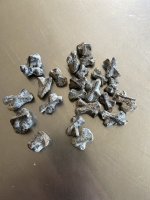fowledup
Silver Member
- Jul 21, 2013
- 2,757
- 5,162
- Detector(s) used
- Whites GMT V/SAT
- Primary Interest:
- Prospecting
I've noticed that on the latest version of a Ca. BLM map I have that the Section lines have moved as much as 300' in spots from the previous edition. How does this effect claim boundaries? If contested, what would be the standard by which to go by- the most current mapping data, or historical reference from maps available at time of location?
Amazon Forum Fav 👍
Upvote
0










